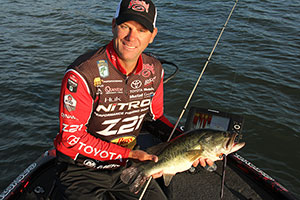 Kevin VanDamThe continual evolution of tackle and technique trends amazes me.
Kevin VanDamThe continual evolution of tackle and technique trends amazes me.
I’ve been stunned by how things have changed and how technology has expedited those changes in recent years. Our improved tackle has made us far more efficient on the water than we were 10 years ago.
When I first began as pro some 26 years ago, I could go to a Bassmaster event just about anywhere and either flip, throw a spinnerbait or crankbait and be successful.
Today, we have categories of crankbaits, topwaters, jerkbaits, jigs, swimbaits and soft plastics designed for specific presentations.
We need all of those and more because even the best fisheries have taken their toll due to heavy fishing pressure.
That’s why you’re seeing such an influx of finesse tactics working on waters where anglers previously would never consider them. An angler needs a repertoire of finesse tactics/baits to be successful on tour these days.
Sure, there are instances where you can power fish four days straight and win an Elite event but, without question, you better have a finesse backup plan.
It’s kinda funny when you consider that the Carolina rig was probably the original finesse rig on the tournament circuit. It still works, but by the drop-shot has become a more dominate player.
Other finesse presentations catch fish, but the drop-shot is so versatile.
Just look at the results of the recent Potomac event. Justin Lucas fished a community hole that gets pounded by jig and worm fishermen. He led all four days fishing that massive parking lot dock with a drop shot, a presentation that he believes that fish using that dock have never seen.
As he proved, the drop shot is so versatile and efficient. Anglers are discovering it’s not just a rig for fishing fish vertically in clear water. It’s catching fish in grass, stained water, shallow water and around structures where we previously never considered fishing it.
While the finesse worm is the standard, you can put just about any soft bait on it and catch fish. The options are unlimited.
We’ve also found that there is more to rigging than tying on a hook, weight and bait. Leader length can be critical whether you’re casting or fishing vertically. Weight size is another key consideration; it’s easy tie on a heavy weight and go fishing but you’re better off tying on the lightest you can use to maintain bottom contact and keep the line tight.
Tungsten sinkers (rather than lead) can make a difference. Tungsten is harder, hence more sensitive, so you can feel the bottom terrain better. It also is smaller, so it doesn’t detract from the visual benefits of the bait.
Hooks have improved and are more specialized. For example, my Mustad Grip Pin for drop shotting has a molded keeper to hold the plastic securely when fishing the lure weedless. Other hook styles are offered for various fishing situations that the drop-shotter may encounter.
We’ve determined that small diameter braid (8 to 10 pound) used as the main line and tied to a light fluorocarbon leader is more efficient. The braid offers more sensitivity to feel the subtle bites and durability for fishing around grass while the fluorocarbon leader provides a near invisible line for attaching the bait. More importantly, your line doesn’t twist like it does with straight mono or fluorocarbon.
If you haven’t added the drop shot to your arsenal, you should. It’s always going to be a player, especially on pressured lakes, because of its versatility and natural appearance.
Remember, it’s all about the attitude!


